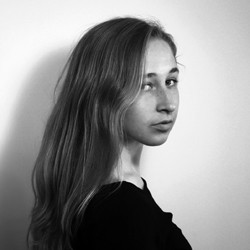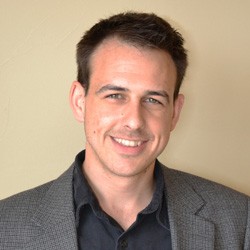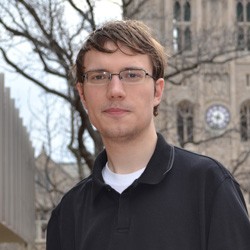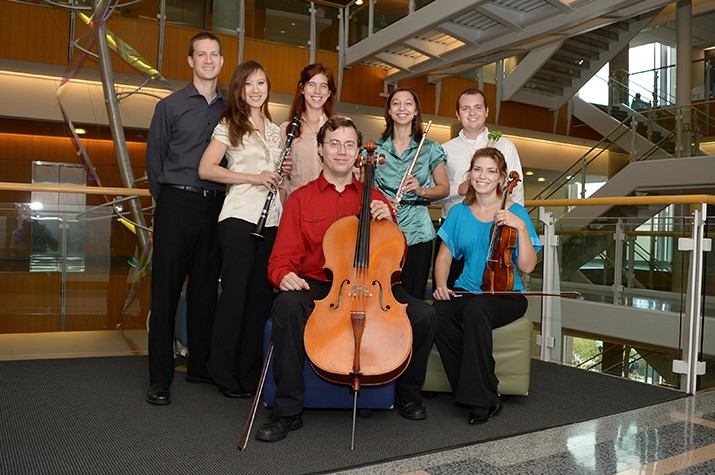Join us for an evening of innovative music and art at the World Chess Hall of Fame. The Mizzou New Music Ensemble will premiere compositions by Hills, Strobel, and Miles inspired by the visionary artwork in Bill Smith: Beyond the Humanities.
Program
Dancing Helix Rituals (2006) — Augusta Read Thomas (b. 1964)
Spherodendron (2013)* — Haley Myers (b. 1993)
Structural Integrity (2013)* — Joe Hills (b. 1987)
Graphyne (2013)* — Robert Strobel (b. 1988)
*World Premiere
Dancing Helix Rituals (2006)
Dancing Helix Rituals was commissioned by the Verdehr Trio and Michigan State University and dedicated with admiration to the Verdehr Trio. It was composed in 2006 and premiered by the Trio on October 21 at the Phillips Collection in Washington, DC.
Somewhat of a cross between “Jazz” (Monk, Coltrane, Tatum, Miles, etc.) and “Classical” (Bartok, Stravinsky, Varèse, Berio, Boulez, etc.), Dancing Helix Rituals can be heard as a lively dance made up of a series of outgrowths and variations, which are organic and, at every level, concerned with transformations and connections. Each player serves as a protagonist as well as fulcrum point on and around which all others’ musical force fields rotate, bloom, and proliferate. There is refined logic to every nuance, which stems from the sound, in context, on its own terms and the form is that of an 8-minute crescendo.
Although Dancing Helix Rituals stands fully on its own as art music, it can be performed along with dancers. The early Stravinsky ballets are works I hold in great reverence, have studied, love, and embrace as models in my inner ear. As I compose at my drafting tables, I sing, dance, move, and conduct. As a result, I tend to hear and feel all of my music as music suitable for dance. My process is visceral with ears and mind both analytical as well as intuitive, i.e. “feeling” and “hearing’” every note, rhythm, and color.
The score is marked with words including passionate, bright, driving, with flair and ritualistic energy, clock-like and mechanical, scurrying and playful, majestic and stately, funky, syncopated, jazzy, colorful, fanfare-like, romp-like, light and bouncy. Varied, colorful, crosscut, unexpected sounds are performed in a manner so as to feel inevitable in the way that a jazz improviser thinks spontaneously. —Augusta Read Thomas

About Augusta Read Thomas
Augusta Read Thomas, born 1964 in Glen Cove, New York, was Mead Composer-in-Residence with the Chicago Symphony Orchestra from 1997 through 2006. In 2009 she was elected to membership to the American Academy of Arts and Letters, an honor society of 250 architects, composers, artists, and writers.
This honor is considered the highest formal recognition of artistic merit in the United States. She taught at the Eastman School of Music from 1993-2001, then was the Wyatt Professor of Music at Northwestern University from 2001-2006. Thomas was appointed University Professor of Composition at the University of Chicago in 2011. In summers she teaches at the Tanglewood Music Center. During her residency with the Chicago Symphony Orchestra, she premiered nine commissioned works, and has had other performances of her works with major orchestras and chamber ensembles throughout the world.
Spherodendron (2013)
When I first viewed Bill Smith’s spherodendron, I was immediately struck by its beautiful intricacy. The “round tree” seemed both delicate, with its thin filaments and illuminated nodes, and strong, in its slow revolutions and concentric layers. Smith comments that this kind of network can exist in many forms: everything from actin filament in cells to social networks to “the ultra mega macro webs that make up the universe.” Indeed, it is easy to imagine the work both as a scientific model and a metaphor for those networks that perhaps evade visibility or understanding. As I viewed this ethereal piece of art and contemplated the networks in my own life, I realized that the experience of realizing these connections can be both blissful and frightening, something that both simplifies and complicates how we understand our lives and the world around us.
I wanted my music to convey the same sense of evolution, contemplation, and mystery that Smith’s sculpture inspired in me. Musical evolution occurs through moments of bright delicacy and melodicism (seeing the star-like, brilliant nodes light up for the first time) that gradually transition into a more dissonant and forceful section (realizing the humongous nature of, and your own inextricability from, the universe’s various networks) at the climax of the piece. As with Smith’s piece, I tried to convey this evolution through a series of “nodes,” or “branching events,” when one instrument diverges in either a melodic or textural variation, but then easily flows back into the ensemble, as the intersecting filaments converge. This idea of sliding between concentric layers is also conveyed through glissandos and ascending melodic gestures. I very much agree with Smith’s assertion that “Understanding complex interactions is required for the positive future,” and greatly enjoyed exploring that idea in the process of writing this piece. Many thanks to Bill Smith for creating his beautiful and thought-provoking piece of art!
—Haley Myers
 About Haley Myers
About Haley Myers
Haley Myers is a native of Columbia, Missouri, and has loved playing and studying music since beginning piano lessons at age six. These piano lessons were also her first experience with composition, as her wonderful teacher, Mrs. Judith LaRose, always encouraged her to experiment at the keyboard and perform her own pieces. Haley first began to compose for other instruments and ensembles when she studied with Dr. Stefan Freund and Dr. Tom McKenney at Mizzou’s Summer Composition Institute for high school students in 2009 and 2010. These positive experiences lead her to pursue her undergraduate studies at Mizzou, and she considers herself very fortunate to be a part of the New Music Initiative there as a recipient of the Sinquefield Scholarship. Haley is currently in her sophomore year, and is pursuing majors in Music and Biology.
Structural Integrity (2013)
Structural Integrity (2013) is based on a sculpture by Bill Smith called structure. The 20-foot tall tower weighs only two ounces and is similar to many natural structures found in our world. The structures that I find most intriguing are hair cells-—sensory receptors for perceiving sound that are found on a microscopic level in almost every mammal.
The overall shape of Structural Integrity reflects that of the damped sine wave that gives Smith’s structure its form. My piece begins with a broad base of octave doublings and eventually tapers down to one line; one note. The constant growth and decay of dynamic, line, and tone color throughout reflects the oscillation of a sine wave as it is interpreted by human ears. These similar swelling shapes create a series of interconnected musical modules that seamlessly transition from one to the other and eventually converge upon a single unison pitch, reminiscent of how the piece began. —Joe Hills

About Joe Hills
Joe Hills (b. 1987) is a composer of many styles, genres, forms, and instrumentations. Particularly interested in obscure or underrepresented instrumentations, Joe has enjoyed composing for unique ensembles like the Mizzou New Music Ensemble. Joe was born and raised in Colorado and is highly interested in promoting music composition and new music in his home state where he feels it is severely underrepresented. Currently Joe is in his last semester of a Master of Music degree in Composition from the University of Missouri-Columbia studying under Dr. W. Thomas McKenney. After graduation, Joe will return to Colorado to promote new music and prepare for his application to doctoral programs seeking a PhD in Music Composition/Theory.
Graphyne (2013)
The contrast between order, light, and their opposites has always struck me as beautiful. In this work, graphyne, I sought to emulate the balance between the pulsating, rotating dots of light, or in musical terms, high-pitched pulsating rhythms, and darkness, i.e. low notes and profoundly slow tempo. Of course, the sculpture features both of these qualities. I based the different musical sections on how I might imagine or perceive the sculpture if I were moving away from the sculpture, focusing more on how the light contrasts with the darkness, or walking towards it, concentrating more on the activity of the sculpture itself. Ultimately, the music walks around the sculpture and observes it from all angles, as a piece of art ought to be examined. Some musical techniques I used were polychords, which I often imagine to be bright pillars of light, and bossa-nova influenced rhythms. The dodecaphonic macrostructure suggests the multitude of colors. Many of the blurry, fast figures at the beginning of the piece were inspired by the points of light which gather inside the sculpture. Overall, the piece is an attempt to juxtapose the complexity of the sculpture with the profundity of the surroundings.
—Robert Strobel

About Robert Strobel
Robert Strobel received his Bachelor of Music in Composition and Performance, Summa Cum Laude, and Master of Music in Performance, with honors, at the University of Northern Colorado. There he studied composition with John McClaird, Paul Elwood, and Robert Ehle. In addition, his oboe teachers have included Lauren Murray, Sara Bierhaus-Mellander, Melissa Peña, and Dan Willett. Currently, he is pursuing an MM in Music Composition at the University of Missouri under the instruction of W. Thomas McKenney.
Among his oeuvre, as of March 2012 are instrumental sonatas, piano works, art songs, choral works, and two works for orchestra. He recently finished a string quartet. His influences range from Ravel, Debussy, and Messiaen to the jazz organist Walter Wanderley. An avid writer, Robert also maintains a blog which has had hits from many countries in Europe. Other interesting hobby-projects he is currently involved with include conceptualizing realistic, but imaginary photographs of a journey through the “Arctic,” and writing a novel—both collaborations.

Mizzou New Music Ensemble
Photo by Gene Royer
Sponsored by the Mizzou New Music Initiative, the Mizzou New Music Ensemble is dedicated to promoting new music at Mizzou through performances on and off campus. The ensemble’s principle contribution is to perform and record music by MU faculty and students as well as established repertoire. In addition, members of the ensemble are expected to support the MU composition program through ad hoc readings, performances, and recordings of student and Creating Original Music Project (COMP) works.
The Mizzou New Music Initiative brings together an array of programs intended to position the University of Missouri School of Music as a leading center in the areas of composition and new music. The Initiative is the direct result of the generous support of Dr. Jeanne and Mr. Rex Sinquefield, and the Sinquefield Charitable Foundation. The Sinquefields’ vision is to create an incubator for the composition and performance of new music, and to position Missouri as a major center for the music of tomorrow.
Programming made possible by the Sinquefield Charitable Foundation.
PRESS
5/1/13: STL Beacon — World chess exhibit mixes in music, by Johnny Buse


 About Haley Myers
About Haley Myers

